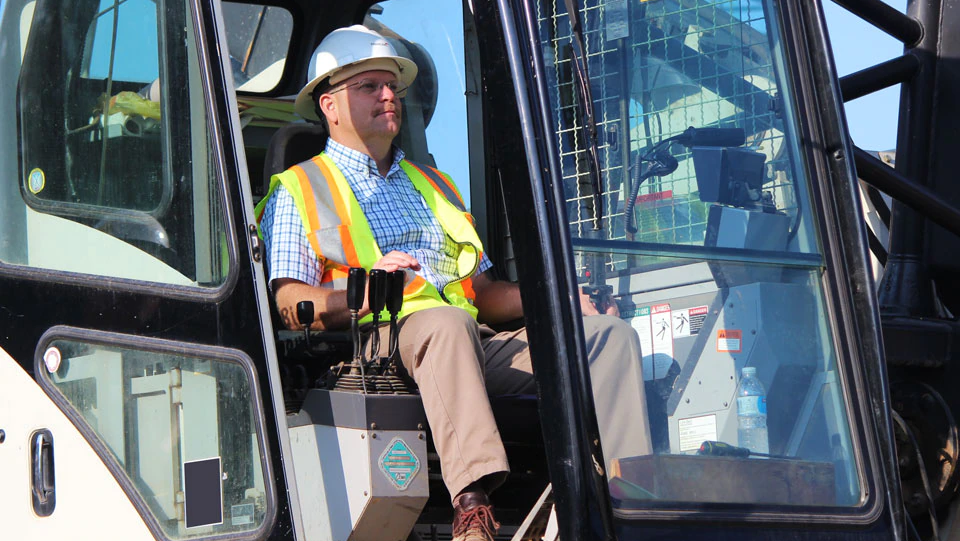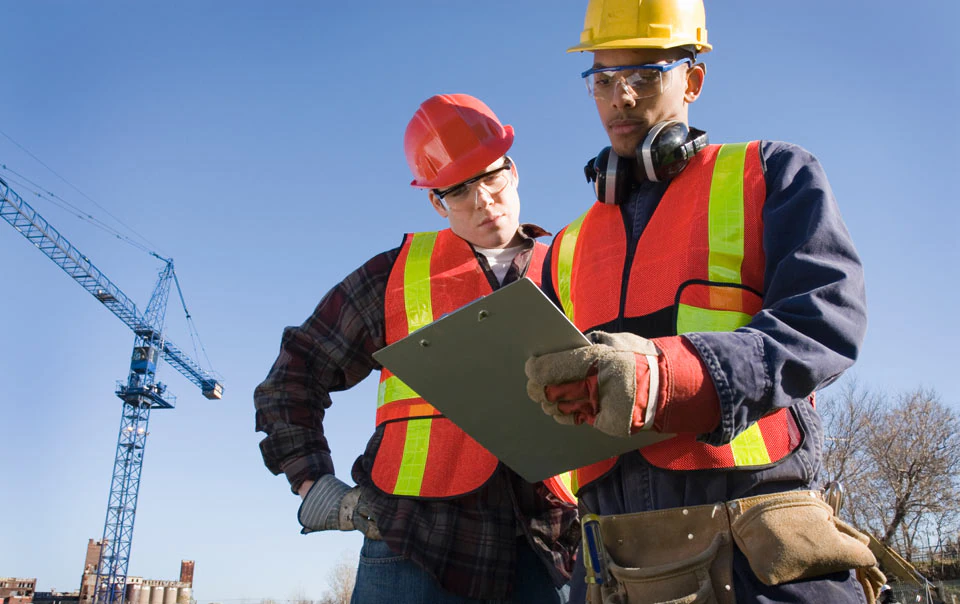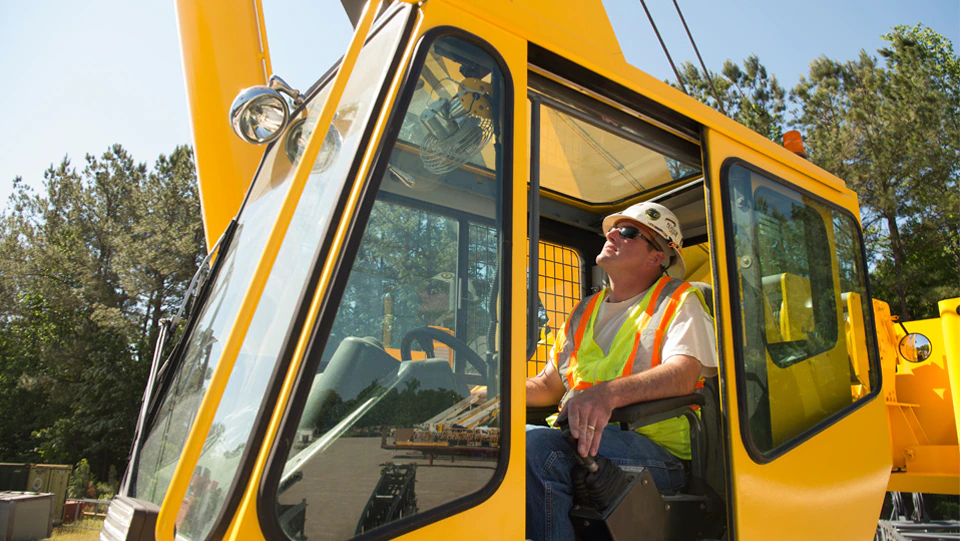Travelers Crane Safety Training Program for Professional Crane Operations

Build a crane safety culture
Cranes are among the most dangerous pieces of equipment on a job site. From windy conditions to the location of power lines, your team needs crane training to be prepared to address all variables that may arise. Federal or state certification for crane operators is required from an accredited crane operator testing organization. With in-person and online sessions, Travelers crane specialists can help train your employees about crane safety.
What is the Travelers Professional Crane Operations Workshop?
What is the Travelers Professional Crane Operations Workshop? It’s a valuable crane training course that gives crane operators the very latest knowledge to safely operate on the job site.
Hear from some of your construction peers who have attended the workshop with Hank Dutton. Attendee feedback includes:
"Probably one of the most impactful trainings I've had to date…"
"I felt it was so valuable that we are going to start sending operators, more supervisors and mechanics that work on the cranes…"
Discover the value of Travelers crane training!
Train for the Crane
(DESCRIPTION)
Text, Train for the Crane. An important message from Hank Dutton. Senior Technical Specialist. Travelers.
(SPEECH)
[ROCK MUSIC]
HANK DUTTON: Construction cranes are responsible for some of the world's most beautiful skylines. They're also responsible for some of the world's worst construction site accidents. Truth is, cranes are only as safe as the people who operate and manage them. That's why, if you're gonna crane, you gotta train. At first, your construction team may not be all that excited about taking a professional crane training course.
SPEAKER 1: Oh, well, I heard it was going to be hard.
SPEAKER 2: It was a sort of "volun-told."
RANDY GOODE: Crane training-- I thought, oh no, a test.
SPEAKER 3: I get all the big, heavy, more dangerous stuff to lift and pick, so it's very important for me to do that correctly.
HANK DUTTON: But once they've completed the course, it's a whole other story.
TERRY SUBLETT: That's going great, actually. I've learned a lot. They've taught me a lot of processes and things that I never would've thought of before.
CHRISTOPHER SMITH: I'm excited about this training for the broad spectrum of information, and learning multiple cranes, and how they work, function.
RANDY GOODE: Knowing my coworkers are doing the same training, it'll make a safer environment for us to work in. And everybody will have knowledge and training of what's going on. And that's a good thing in my line of work.
DON ADKINS: The Travelers training has helped us to develop confidence in each other. Where the supervisor now trusts the operator even more, because he's obtained certification and is thoroughly trained, which makes the crew much more cohesive.
ED LAVALLEE: In my role as a broker, it's always trying to put the latest and greatest information and technologies out there to my clients to help improve their program. And this is certainly one of those that I would highly recommend to anybody.
MIKE FERRY: It's opened everyone's eyes to what we should be focusing on on crane safety and crane setup, and holding our subcontractors, as well as ourselves, when we self-perform with cranes. In my 13 years of taking a lot of safety training, to be honest, it was probably the most impactful training I've had to date.
JOHN GEMETRO: I've felt it was so valuable that we're going to be sending operators more supervision, and mechanics that do the maintenance of the crane. Just because something hasn't happened in the past doesn't mean that it can't happen in the future.
HANK DUTTON: Many students taking Travelers' professional crane operations course moved from petrified to certified. In fact, of the 6,000 construction workers we've trained, over 80% have passed the written certification exam. At the end of the day, what matters most is that everyone gets home safe and sound.
(DESCRIPTION)
Text, Crane responsibly. Enroll in this customer-only training. Contact your Travelers representative today. Travelers. A white umbrella at the end of the text. Travelers dot com.
(SPEECH)
[ROCK MUSIC]
Check out some of our Travelers crane safety training videos
Hosted by Hank Dutton, Travelers Senior Specialist
Dangers of rigging mode
You shouldn't override the crane's computer just to get a different answer. Learn why bypassing computer controls using Rigging Mode is not recommended.
This content brought to you by Travelers
Drawing the Line on Crane Safety_ Rigging Mode
(SPEECH)
[MUSIC PLAYING]
(DESCRIPTION)
Text, Drawing the line on safety. Rigging mode.
(SPEECH)
SPEAKER 1: When your mom didn't give you the answer you wanted, what did you do? Right, you asked your dad. This is not a good strategy when lifting. Cranes are designed with operator aides, some of them computerized to help prohibit unsafe operations. Bypassing computer controls, using rigging mode in order to perform operations a crane wouldn't otherwise allow may seem like a convenient shortcut. But it's often the quickest route to disaster. Dangerous situations like overloading or tube blocking could occur. Don't be a cowboy and try to cheat the system. Only use rigging mode when permitted by the crane manufacturer. Don't use the override feature just to get a different answer. And remember, when your mom says no, it means no.
[MUSIC PLAYING]
(DESCRIPTION)
Construction solutions from end to end. Brought to you by Hank Dutton, senior technical specialist with Travelers Construction Risk Control. Travelers. For more information contact your rep. Travelers Logo For more information on the Travelers Professional Crane Operations training program, contact your Travelers representative.
Learn more about Travelers crane training courses for our customers
Our crane specialists, including Hank Dutton, deliver crane training for our customers across the country. This video highlights the Professional Crane Operations Course offered by Travelers.
This content brought to you by Travelers
Drawing the Line on Crane Safety
(SPEECH)
[MUSIC PLAYING]
(DESCRIPTION)
Text, Drawing the line on safety.
(SPEECH)
HANK DUTTON: With every lift comes great responsibility. Think about it. A crane can be the most expensive, most critical, and most dangerous piece of equipment on your job site. One false move can destroy your budget and your schedule, or worse. A certified crane operator is not a replacement for a safety program, and the burden of risk should never fall just on the shoulders of a crane operator alone. Having a knowledgeable team that's well-versed in crane safety to check the operation every step of the way is the best approach. Having skilled and knowledgeable operators, riggers, lift directors, and site supervisors can lead to much safer, more efficient worksite. We're invested in helping you identify risk and ways to mitigate. Our training is designed to help you build a culture of safety. Over the past 10 years, Travelers has trained 6,000 employees to the highest standards. We'll do more than just prepare you for exams. Over 80% of our training participants have passed the certification test. A skilled team is more than just good business, it's the right thing to do for your employees, your job, and the community.
[MUSIC PLAYING]
(DESCRIPTION)
Text, Construction solutions from end to end. Brought to you by Hank Dutton, Senior Technical Specialist with Travelers Construction Risk Control.
Travelers Logo
For more information on the Travelers Professional Crane Operations training program, contact your Travelers representative.
Understanding Line Pull
Line Pull is one of the most overlooked concepts when determining crane capacity. It is also commonly missed on crane certification exams. Just like fishing for a “big one,” learn how your line must be sufficient for the weight you are reeling in.
This content brought to you by Travelers
Drawing the Line on Crane Safety_ Line Pull
(DESCRIPTION) Text, Drawing the line on safety. Line pull.
(SPEECH)
[MUSIC PLAYING]
HANK DUTTON: Listen up. A commonly overlooked factor when determining the crane's rate of capacity, the amount of weight the crane can safely lift, is line pull line pull may vary depending on the crane manufacturer. It refers to the pulling force of the winch or the maximum permissible load of the wire rope. It's also one of the most often misunderstood concepts on crane certification exams. Here's an analogy for you. If you go fishing with 5-pound test line, would you expect to be able to catch a 20- pound fish? Right. Even with an extra strong rod, that fish would never make it into the boat. The same holds true for cranes. You need to ensure that the crane has enough parts of the line reeved before attempting a lift. Just like the 5-pound test, 20-pound fish example, of all the factors you need to consider, it's the weakest one that will limit what you can lift. Remember that the next time you're fishing for a big one. Oh, and I like mine fried.
[MUSIC PLAYING]
(DESCRIPTION)
Construction solutions from end to end. Brought to you by Hank Dutton, Senior Technical Specialist with Travelers Construction Risk Control.
Travelers Logo
For more information on the Travelers Professional Crane Operations training program, contact your Travelers representative.
Chart is a chart
We don't live in a perfect world or operate our cranes in one either. Learn some of the factors you should consider beyond the chart.
This content brought to you by Travelers
Drawing the Line on Crane Safety_ Chart is a Chart (SPEECH)
[MUSIC PLAYING]
(DESCRIPTION)
Text, Drawing the line on safety. Chart is a chart.
(SPEECH)
SPEAKER 1: Rated capacity charts for cranes assume near perfect to perfect conditions. But let's face it, we don't live in a perfect world or lift in one either. If you're lifting a load based on numbers from the capacity chart alone, you could be in for some unpleasant surprises. When you consider the effect variables like wind force, load weights that may not be accurate, or setups that are less than perfect, things can change dramatically and impact the crane's ability to lift a load. Think of lifting something with a large surface area under windy conditions, like a wall panel. There are multiple things that can go wrong if not considered ahead of time. In this scenario, the wind can apply pressure against the loaded boom causing an increase in the loads weight that exceeds the cranes rate of capacity charge, which can result in the crane turning over or braking. The load can sway from side to side, which can potentially lead to boom failure. Or the load could be pushed to a longer radius causing the crane to tip over. So draw the line on safety, understand the rate of capacity as well as the variables affecting it before making a lift.
[MUSIC PLAYING]
(DESCRIPTION)
Construction solutions from end to end. Brought to you by Hank Dutton, Senior Technical Specialist with Travelers Construction Risk Control. Travelers. For more information, contact Travelers. Travelers Logo For more information on the Travelers Professional Crane Operations training program, contact your Travelers representative.
Certification vs. qualification
Certified does not always mean qualified. Explore the difference between certification and qualification as it relates to crane operators.
This content brought to you by Travelers
Drawing the Line on Crane Safety_ Certification vs. Qualification
(SPEECH)
[MUSIC PLAYING]
(DESCRIPTION) Drawing the line on Safety certification versus qualification. (SPEECH) SPEAKER 1: You wouldn't hop behind the wheel of a Formula One car just because you have a driver's license, would you? By the same token just because a crane operator is certified to operate a type of crane, it doesn't mean he or she is necessarily qualified to operate all cranes. Certification means a candidate has passed the required test and should know basic crane functions for the category of cranes they tested on. But qualification refers to a higher level of knowledge about the safe operation of specific models and types of cranes. How much time has your operator spent on a rough terrain crane, a truck crane, an all terrain crane, a crawler crane, a carrier deck, or a boom truck?
[CRANE BUGLE CALL]
(DESCRIPTION)
A bird crane squawks.
(SPEECH)
Very funny. Operators need to familiarize themselves with a specific crane they're asked to operate. And employers need to ensure whether or not crane operators are qualified, rather than simply certified in order to draw the line on safety.
[MUSIC PLAYING]
(DESCRIPTION) Construction solutions from end to end brought to you by Hank Dutton, senior technical specialist with Travelers construction risk control. Logo, Travelers. For more information contact your Travelers representative.
Travelers Logo
For more information on the Travelers Professional Crane Operations training program, contact your Travelers representative.
Beware the risks posed by hidden site conditions
Construction site conditions can have an effect on the safe operations of a crane. This video highlights information from the Travelers Professional Crane Operations course to help you evaluate site conditions and heighten your awareness to proper crane setup.
This content brought to you by Travelers
Drawing the Line on Crane Safety_ Ground Conditions
(DESCRIPTION)
Text, Drawing the line on safety. Ground conditions.
(SPEECH)
SPEAKER: If the ground can't hold the crane, the crane can't hold the load. Words of wisdom that might sound pretty simple, but really ground surface can be complicated when it comes to safe crane operation. What about hidden conditions like buried utilities? Consider ground bearing pressure. The ground can't always hold the crane when pressure is exerted. Rollovers are one of the leading causes of crane accidents. Does your lift team know the risk and requirements of spreading and transmitting the load? The answer to these questions and more is always proper training.
(DESCRIPTION) Text, Construction solutions from end to end. Brought to you by Hank Dutton, Senior Technical Specialist with Travelers Construction Risk Control. Travelers Logo For more information on the Travelers Professional Crane Operations training program, contact your Travelers representative.
Learn how to use capacity charts
Rated capacity charts are complicated, and a job site is no place for guesswork. This video highlights information from the Travelers Professional Crane Operations Course that illustrates how load chart calculations help to determine how much weight can be safely lifted using the crane.
This content brought to you by Travelers
Drawing the Line on Crane Safety_ Load Charts
(DESCRIPTION)
Drawing the line on safety, Load charts. A drawn crane drops load.
(SPEECH)
[UPBEAT MUSIC PLAYING]
SPEAKER: The number on the chart is not always the amount of weight permitted on the hook. When it comes to determining if a lift is safe or not, even small miscalculations can lead to serious accidents. Graded capacity charts have gotten more complicated. When it comes to determining what the crane can safely lift, you need to understand what numbers to use. Garbage in equals garbage out. If you don't have the right numbers even a calculator will give you the wrong answer. A job site is no place for guesswork. It's critical to the safety of the job and the people on it to get the numbers right each and every time. Don't let one wrong number derail your next left.
(DESCRIPTION)
Construction solutions from end to end. Brought to you by Hank Dutton, senior technical specialist with Travelers construction risk control.
Travelers Logo
For more information on the Travelers Professional Crane Operations training program, contact your Travelers representative.
(SPEECH)
[UPBEAT MUSIC ENDS]
Ensure that everyone is trained in crane safety
Knowledge is important for everyone involved in crane operations. This video reinforces the importance of lift planning to help keep your team safe and understand its responsibility.
This content brought to you by Travelers
Drawing the Line on Crane Safety_ Lift Planning
(SPEECH)
[MUSIC PLAYING]
(DESCRIPTION)
Text, Drawing the Line on Safety. Lift Planning. Travelers.
(SPEECH)
SPEAKER 1: None of us are as smart as all of us. One smart crane operator may not be enough. You and other members of your lift team should know what your operator knows. Does your team understand the lift plan and what can affect the operation? People often think of planning only when heavy loads are involved. The fact is lifts involving light loads placed at long radii can just as easily end in failure. What's more, variables like power lines, weather, and win make smart lift planning essential and educating all members of your safety team critical. Your success can depend on your team being prepared.
[MUSIC PLAYING]
(DESCRIPTION)
Hank Dutton, Senior Technical Specialist, Travelers Construction Risk Control. For more information on the Crane Operations training program, contact your rep.
Travelers Logo
For more information on the Travelers Professional Crane Operations training program, contact your Travelers representative.
Construction industry insurance
Now is the time to work with an insurer with a deep understanding of the construction industry. Travelers is committed to bringing responsive and creative solutions to a wide range of contractors. We provide a cornerstone for contractors to realize their vision, as they build America's communities.
Industry expertise
We offer product and service breadth to serve a wide range of contractors, including:

Hank Dutton, Travelers Senior Specialist
Hank Dutton, Senior Specialist at Travelers, is a NCCCO certified lift director. Dutton has been employed at Travelers for over 20 years as part of a team of construction safety professionals. As a 25-plus-year veteran of the construction industry, he has worked with a diverse group of contractors, covering most types of construction. Dutton's deep experience allows him to regularly assist clients with questions relating to cranes and rigging.
More Prepare & Prevent
Insights to help you manage risks at work and on the road
Construction Resources
What Are Roles and Responsibilities During Crane Operations?
Having a well-trained team is an important aspect of crane safety. Learn about the responsibilities of four key roles during crane operations.

Construction Resources
Going Beyond OSHA's Minimum Standards for Crane Safety
Companies preparing for crane operator OSHA certification should also train their supporting team about ongoing safe crane operations.

Construction Resources
5 Key Questions for Developing a Sound Lift Plan
A well-crafted crane lift plan can help your team stay safe. Here are some considerations when developing a lift plan.

